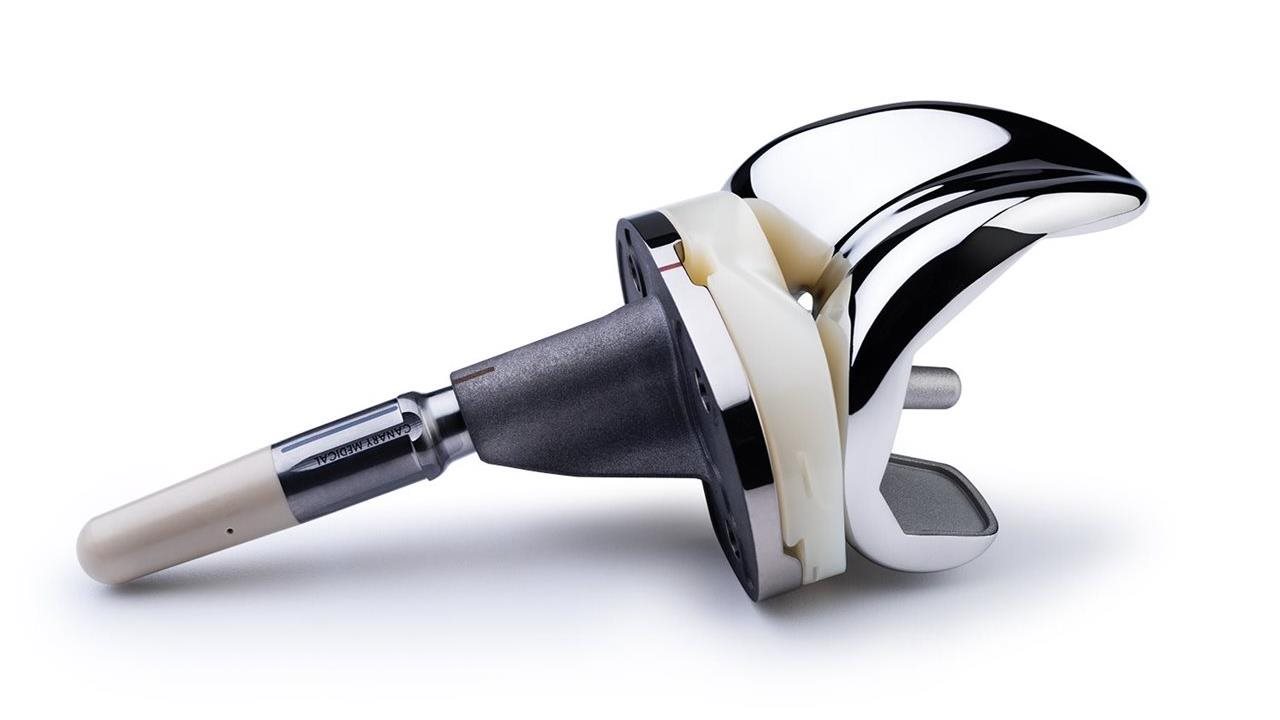2024-06-24T09:01:00
(BPT) – Imagine going to work and, in the middle of leading a staff meeting, you start slurring your words. You don’t feel ill and nothing like this has ever happened before. You have no explanation as to what could be going on, but you shake it off and go about your day like normal.
Later that evening, the same slurred speech comes back over dinner. Then again during a walk around the neighborhood. Now you’re starting to get concerned.
This was Mike’s experience one day in 2011, a day that should have been like many others — working as a manager at an aerospace company followed by dinner with his wife. While Mike was inclined to dismiss the sudden slurring, his wife was worried and insisted that he schedule a doctor appointment for the very next day.
“The next morning, I sat in the exam room with my general practitioner, and he listened carefully as I explained the strange symptoms. He looked at my eyes and had me gaze at his finger as he moved it around. He checked my throat muscles and decided that I needed to have blood drawn,” said Mike.
“He said that I might have generalized myasthenia gravis or gMG. He didn’t explain what it was or why he thought it was gMG at that time. A few days later, I received a call from him that the blood test confirmed his suspicions that I had gMG.”
What is gMG?
gMG is a rare autoimmune neuromuscular disease that can lead to a loss of muscle function and can cause severe muscle weakness. The diagnosed prevalence of gMG in the U.S. is estimated at approximately 90,000.
An estimated 80% of people with gMG are anti-acetylcholine receptor (AChR) antibody positive, meaning they produce anti-AChR antibodies that bind to signal receptors at the neuromuscular junction (NMJ), the connection point between nerve cells and the muscles they control. This binding activates the C5 complement protein, part of the body’s immune system, in an uncontrolled manner. As a result, the immune system attacks the NMJ, which leads to inflammation and a breakdown in communication between the brain and the muscles.
This inflammation and breakdown in communication is why Mike had difficulty speaking on the first day his symptoms arose and why he’d soon have trouble chewing and swallowing as well.
Other symptoms of gMG may include double vision, droopy eyelids and lack of balance, which can potentially be followed by more severe symptoms including extreme muscle fatigue, choking and respiratory failure as the disease progresses.
Mike considers himself lucky that his physician had previous experience with autoimmune diseases and recognized his symptoms as gMG. Patients can sometimes go years without a correct diagnosis, leaving them without a management plan for the disease.
Mike’s treatment journey
After his anti-AChR antibody positive gMG diagnosis, Mike’s doctor referred him to a neurologist for further evaluation. He met with several specialists and started his treatment plan.
“I was still experiencing some symptoms. I now know that many of us experience gMG differently, and after speaking with and seeing other patients, I wanted to do what I could to manage my symptoms,” he said.
Mike adapted his lifestyle and learned to make adjustments to make things easier for himself. For work, they moved him into a position that was less demanding. Mike limited his evening activities because his muscle fatigue made it hard to participate. He took breaks when watching and playing with his grandkids. In 2018, Mike learned about potential treatment options and a doctor a few hours away who specialized in treating gMG patients. After running some initial tests, his doctor started him on SOLIRIS® (eculizumab), a C5 complement inhibitor treatment for adult patients with anti-AChR antibody positive gMG.
Mike’s doctor explained that SOLIRIS is a medicine that affects your immune system and may lower the ability of your immune system to fight infections, and because of this, SOLIRIS increases your chance of getting serious meningococcal infections that may quickly become life-threatening or cause death if not recognized and treated early.
Mike received his meningococcal vaccines two weeks before his first dose of SOLIRIS.
At first, Mike had the intravenous (IV) infusions every week, and then after five weeks, he received the treatment every other week. Mike received the IV infusion usually over 35 minutes and was monitored after each infusion for at least one hour for allergic and infusion-related reactions. Mike continued to work with his doctor to manage his symptoms and discuss any concerns surrounding his treatment plan. Then in 2021, he learned that ULTOMIRIS® (ravulizumab-cwvz), a long-acting C5 inhibitor, was being investigated for adults with anti-AChR antibody positive gMG, which would allow patients to receive treatments every eight weeks, starting two weeks after an initial dose.
When the U.S. Food and Drug Administration (FDA) approved this use for ULTOMIRIS in 2022, Mike and his doctor discussed the benefits and important safety information for ULTOMIRIS, including the same risk as SOLIRIS regarding serious meningococcal infections, and the most common side effects for ULTOMIRIS which include diarrhea and upper respiratory tract infections. They then started the process of changing his treatment, ensuring Mike was up to date on his meningococcal vaccinations and that the ULTOMIRIS initiation was timed to two weeks after his last dose of SOLIRIS. Mike is monitored after each ULTOMIRIS infusion for at least 1 hour for allergic and infusion-related reactions.
“There were several reasons I was excited about transitioning to ULTOMIRIS. The first reason was that with ULTOMIRIS, the every eight-week infusion schedule after the loading dose worked for my vacation schedules. The other big reason I wanted to take ULTOMIRIS is that my doctor and infusion center are a two-hour drive from my house. Making that trip every eight weeks instead of every other week was very appealing,” he said.
Living life with gMG
Mike’s advice to others with a gMG diagnosis: First, find a healthcare provider who is familiar with gMG. Second, let people know about your condition so they can help. Finally, know your limits and don’t push yourself too hard.
This is Mike’s personal gMG journey. Not all patients respond to therapy the same way. Individual results and experiences may vary. It is always important to consult with your doctor to determine what treatment is right for you.
This article is sponsored by Alexion, AstraZeneca Rare Disease.
###
INDICATION & IMPORTANT SAFETY INFORMATION FOR ULTOMIRIS® (ravulizumab-cwvz) [injection for intravenous use, 300mg/3mL vial]
INDICATION
What is ULTOMIRIS?
ULTOMIRIS is a prescription medicine used to treat adults with a disease called generalized Myasthenia Gravis (gMG) who are anti-acetylcholine receptor (AChR) antibody positive. It is not known if ULTOMIRIS is safe and effective for the treatment of gMG in children.
IMPORTANT SAFETY INFORMATION
What is the most important information I should know about ULTOMIRIS?
ULTOMIRIS is a medicine that affects your immune system and may lower the ability of your immune system to fight infections.
- ULTOMIRIS increases your chance of getting serious meningococcal infections that may quickly become life-threatening or cause death if not recognized and treated early.
- You must complete or update meningococcal vaccine(s) at least 2 weeks before your first dose of ULTOMIRIS.
- If you have not completed your meningococcal vaccines and ULTOMIRIS must be started right away, you should receive the required vaccine(s) as soon as possible.
- If you have not been vaccinated and ULTOMIRIS must be started right away, you should also receive antibiotics for as long as your healthcare provider tells you.
- If you had a meningococcal vaccine in the past, you might need additional vaccines before starting ULTOMIRIS. Your healthcare provider will decide if you need additional meningococcal vaccines.
- Meningococcal vaccines do not prevent all meningococcal infections. Call your healthcare provider or get emergency medical care right away if you get any of these signs and symptoms of a meningococcal infection: fever, fever with high heart rate, headache and fever, confusion, muscle aches with flu-like symptoms, fever and a rash, headache with nausea or vomiting, headache with a stiff neck or stiff back, or eyes sensitive to light.
Your healthcare provider will give you a Patient Safety Card about the risk of serious meningococcal infection. Carry it with you at all times during treatment and for 8 months after your last ULTOMIRIS dose. Your risk of meningococcal infection may continue for several months after your last dose of ULTOMIRIS. It is important to show this card to any healthcare provider who treats you. This will help them diagnose and treat you quickly.
ULTOMIRIS is only available through a program called the ULTOMIRIS and SOLIRIS Risk Evaluation and Mitigation Strategy (REMS). Before you can receive ULTOMIRIS, your healthcare provider must: enroll in the REMS program; counsel you about the risk of serious meningococcal infections; give you information about the signs and symptoms of serious meningococcal infection; make sure that you are vaccinated against serious infections caused by meningococcal bacteria, and that you receive antibiotics if you need to start ULTOMIRIS right away and are not up to date on your vaccines; give you a Patient Safety Card about your risk of meningococcal infection.
ULTOMIRIS may also increase the risk of other types of serious infections, including Streptococcus pneumoniae, Haemophilus influenzae, and Neisseria gonorrhoeae. Certain people may be at risk of serious infections with gonorrhea.
Who should not receive ULTOMIRIS?
Do not receive ULTOMIRIS if you have a serious meningococcal infection when you are starting ULTOMIRIS.
Before you receive ULTOMIRIS, tell your healthcare provider about all of your medical conditions, including if you: have an infection or fever, are pregnant or plan to become pregnant, and are breastfeeding or plan to breastfeed. It is not known if ULTOMIRIS will harm your unborn baby or if it passes into your breast milk. You should not breastfeed during treatment and for 8 months after your final dose of ULTOMIRIS.
Tell your healthcare provider about all the vaccines you receive and medicines you take, including prescription and over-the-counter medicines, vitamins, and herbal supplements which could affect your treatment.
What are the possible side effects of ULTOMIRIS?
ULTOMIRIS can cause serious side effects including infusion-related reactions. Symptoms of an infusion-related reaction with ULTOMIRIS may include lower back pain, abdominal pain, muscle spasms, changes in blood pressure, tiredness, feeling faint, shaking chills (rigors), discomfort in your arms or legs, bad taste, or drowsiness. Stop treatment of ULTOMIRIS and tell your healthcare provider right away if you develop these symptoms, or any other symptoms during your ULTOMIRIS infusion that may mean you are having a serious infusion-related reaction, including: chest pain, trouble breathing or shortness of breath, swelling of your face, tongue, or throat, and feel faint or pass out.
The most common side effects of ULTOMIRIS in people with gMG are diarrhea and upper respiratory tract infections.
Tell your healthcare provider about any side effect that bothers you or that does not go away. These are not all the possible side effects of ULTOMIRIS. For more information, ask your healthcare provider or pharmacist. Call your healthcare provider right away if you miss an ULTOMIRIS infusion or for medical advice about side effects. You may report side effects to FDA at 1-800-FDA-1088.
Please see the full Prescribing Information and Medication Guide for ULTOMIRIS, including Boxed WARNING regarding serious meningococcal infections.
INDICATION & IMPORTANT SAFETY INFORMATION FOR SOLIRIS® (eculizumab) [injection for intravenous use, 300mg/3mL vial]
INDICATION
What is SOLIRIS?
SOLIRIS is a prescription medicine used to treat adults with generalized myasthenia gravis (gMG) who are anti-acetylcholine receptor (AChR) antibody positive. It is not known if SOLIRIS is safe and effective in children with gMG.
IMPORTANT SAFETY INFORMATION
What is the most important information I should know about SOLIRIS?
SOLIRIS is a medicine that affects your immune system and may lower the ability of your immune system to fight infections.
- SOLIRIS increases your chance of getting serious meningococcal infections that may quickly become life-threatening or cause death if not recognized and treated early.
- You must complete or update your meningococcal vaccine(s) at least 2 weeks before your first dose of SOLIRIS.
- If you have not been vaccinated and SOLIRIS must be started right away, you should receive the required vaccine(s) as soon as possible.
- If you have not been vaccinated and SOLIRIS must be started right away, you should also receive antibiotics for as long as your healthcare provider tells you.
- If you had a meningococcal vaccine in the past, you might need additional vaccines before starting SOLIRIS. Your healthcare provider will decide if you need additional meningococcal vaccines.
- Meningococcal vaccines do not prevent all meningococcal infections. Call your healthcare provider or get emergency medical care right away if you get any of these signs and symptoms of a serious meningococcal infection: fever, fever with high heart rate, headache and fever, confusion, muscle aches with flu-like symptoms, fever and rash, headache with nausea or vomiting, headache with a stiff neck or stiff back, or eyes sensitive to light.
Your healthcare provider will give you a Patient Safety Card about the risk of serious meningococcal infection. Carry it with you at all times during treatment and for 3 months after your last dose of SOLIRIS. Your risk of meningococcal infection may continue for several weeks after your last dose of SOLIRIS. It is important to show this card to any healthcare provider who treats you. This will help them diagnose and treat you quickly.
SOLIRIS is only available through a program called the ULTOMIRIS and SOLIRIS Risk Evaluation and Mitigation Strategy (REMS). Before you can receive SOLIRIS, your healthcare provider must: enroll in the REMS program; counsel you about the risk of serious meningococcal infections; give you information about the signs and symptoms of serious meningococcal infection; make sure that you are vaccinated against serious infections caused by meningococcal bacteria, and that you receive antibiotics if you need to start SOLIRIS right away and you are not up to date on your vaccines; give you a Patient Safety Card about your risk of meningococcal infection.
SOLIRIS may also increase the risk of other types of serious infections, including Streptococcus pneumoniae, Haemophilus influenzae, and Neisseria gonorrhoeae. Certain people may be at risk of serious infections with gonorrhea. Certain fungal infections (Aspergillus) may occur if you take SOLIRIS and have a weak immune system or a low white blood cell count.
Who should not receive SOLIRIS?
Do not receive SOLIRIS if you have a serious meningococcal infection when you are starting SOLIRIS.
Before you receive SOLIRIS, tell your healthcare provider about all of your medical conditions, including if you: have an infection or fever, are pregnant or plan to become pregnant, and are breastfeeding or plan to breastfeed. It is not known if SOLIRIS will harm your unborn baby or if it passes into your breast milk.
Tell your healthcare provider about all the vaccines you receive and medicines you take, including prescription and over-the-counter medicines, vitamins, and herbal supplements which could affect your treatment.
What are the possible side effects of SOLIRIS?
SOLIRIS can cause serious side effects including serious infusion-related reactions. Tell your healthcare provider or nurse right away if you get any of these symptoms during your SOLIRIS infusion: chest pain, trouble breathing or shortness of breath, swelling of your face, tongue, or throat, and feel faint or pass out. If you have an infusion-related reaction to SOLIRIS, your healthcare provider may need to infuse SOLIRIS more slowly, or stop SOLIRIS.
The most common side effects in people with gMG treated with SOLIRIS include: muscle and joint (musculoskeletal) pain.
Tell your healthcare provider about any side effect that bothers you or that does not go away. These are not all the possible side effects of SOLIRIS. For more information, ask your healthcare provider or pharmacist. Call your healthcare provider for medical advice about side effects. You may report side effects to FDA at 1-800-FDA-1088.
Please see the full Prescribing Information and Medication Guide for SOLIRIS, including Boxed WARNING regarding serious meningococcal infections.
AstraZeneca and its Rare Disease Unit, Alexion, are committed to raising awareness of the disease and the need for treatment options. Learn more at Alexion.com and Astrazenecaus.com. You can also visit ultomirisgmg.com.
ALEXION, the Alexion logo, SOLIRIS and ULTOMIRIS are registered trademarks of Alexion Pharmaceuticals, Inc. © 2024, Alexion Pharmaceuticals, Inc. All rights reserved. All other trademarks are property of their respective owners.
US/SOL-g/0615 V1 06/2024












